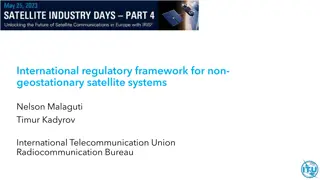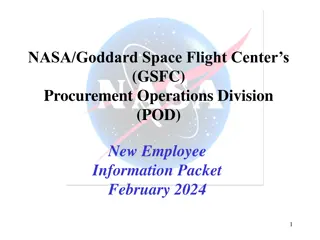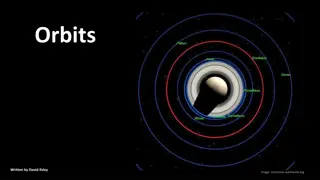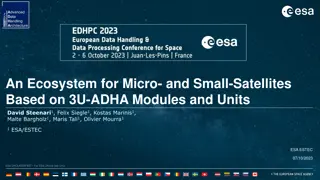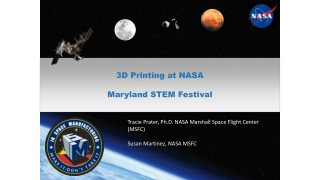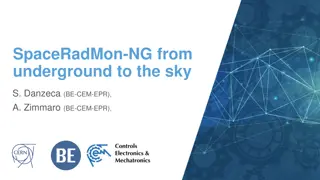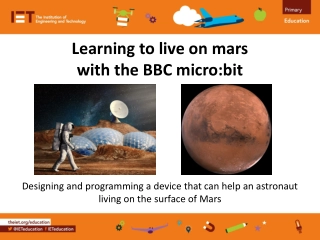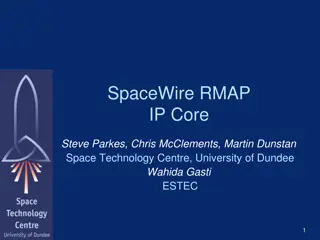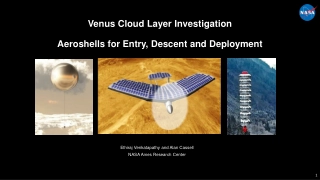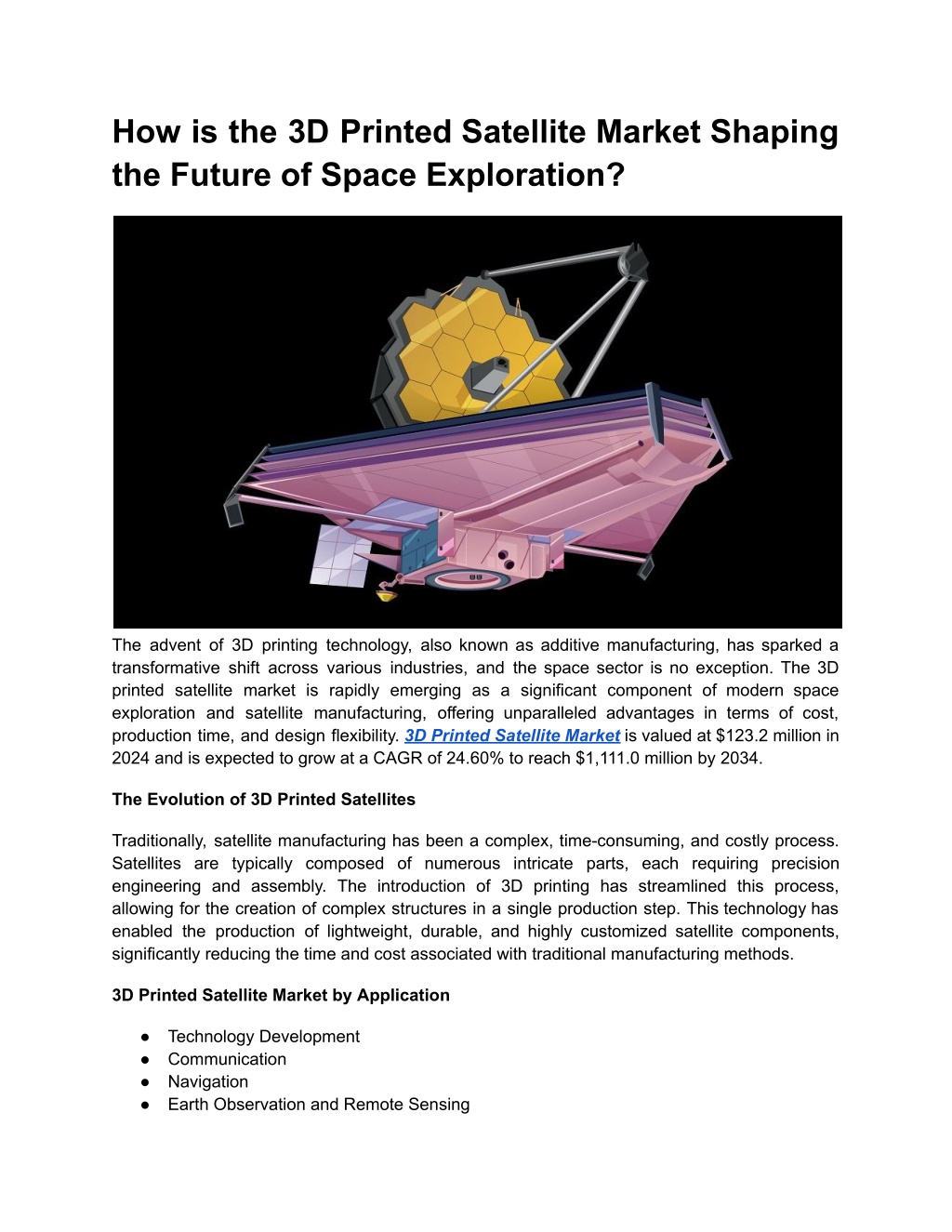
How is the 3D Printed Satellite Market Shaping the Future of Space Exploration?
3D Printed Satellite Mark is valued at $123.2 million in 2024 and is expected to grow at a CAGR of 24.60% to reach $1,111.0 million by 2034.nRead Report Overview: //bisresearch.com/industry-report/3d-printed-satellite-market.html
- 3D Printed Satellite Market
- 3D Printed Satellite Market Report
- 3D Printed Satellite Industry
- Aerospace
- BISResearch
Download Presentation
Please find below an Image/Link to download the presentation.
The content on the website is provided AS IS for your information and personal use only. It may not be sold, licensed, or shared on other websites without obtaining consent from the author. Download presentation by click this link. If you encounter any issues during the download, it is possible that the publisher has removed the file from their server.
Presentation Transcript
How is the 3D Printed Satellite Market Shaping the Future of Space Exploration? The advent of 3D printing technology, also known as additive manufacturing, has sparked a transformative shift across various industries, and the space sector is no exception. The 3D printed satellite market is rapidly emerging as a significant component of modern space exploration and satellite manufacturing, offering unparalleled advantages in terms of cost, production time, and design flexibility. 3D Printed Satellite Market is valued at $123.2 million in 2024 and is expected to grow at a CAGR of 24.60% to reach $1,111.0 million by 2034. The Evolution of 3D Printed Satellites Traditionally, satellite manufacturing has been a complex, time-consuming, and costly process. Satellites are typically composed of numerous intricate parts, each requiring precision engineering and assembly. The introduction of 3D printing has streamlined this process, allowing for the creation of complex structures in a single production step. This technology has enabled the production of lightweight, durable, and highly customized satellite components, significantly reducing the time and cost associated with traditional manufacturing methods. 3D Printed Satellite Market by Application Technology Development Communication Navigation Earth Observation and Remote Sensing
Key Drivers of Market Growth Several factors are driving the growth of the 3D printed satellite market: 1. Cost Efficiency: 3D printing reduces material wastage and minimizes the need for extensive labor, leading to significant cost savings. This is particularly beneficial for small and medium-sized enterprises (SMEs) and startups looking to enter the space industry. 2. Production Speed: Traditional satellite manufacturing can take several months to years. In contrast, 3D printing can produce components in a matter of days or weeks, accelerating the overall production timeline and allowing for faster deployment of satellites. 3. Design Flexibility: 3D printing allows for greater design flexibility, enabling the creation of complex geometries that are difficult or impossible to achieve with conventional manufacturing techniques. This capability facilitates innovation and the development of more efficient and effective satellite designs. 4. Customization: Satellites can be tailored to specific missions and requirements without the need for significant retooling. This customization potential is particularly valuable for niche applications and specialized missions. Request A Free Detailed Sample on 3D Printed Satellite Market! Innovations and Technological Advancements Recent advancements in 3D printing technology have further bolstered the capabilities of the satellite industry. New materials, such as advanced polymers and metal alloys, have been developed to withstand the harsh conditions of space, including extreme temperatures, radiation, and vacuum. Moreover, multi-material 3D printing has enabled the integration of electronic components directly into satellite structures, enhancing functionality and reducing assembly complexity. Innovative companies and research institutions are continuously exploring new frontiers in 3D printed satellite technology. For example, NASA and private companies like SpaceX and Relativity Space are investing heavily in additive manufacturing to produce rocket engines, satellite components, and even entire spacecraft. Market Challenges and Regulatory Considerations Despite the numerous advantages, the 3D printed satellite market faces several challenges. Ensuring the reliability and quality of 3D printed components is critical, as any failure in space can have significant repercussions. Rigorous testing and validation processes are essential to guarantee the performance and safety of these components. Regulatory frameworks also need to evolve to accommodate the unique aspects of 3D printed satellites. International space law, standards for manufacturing, and guidelines for in-space assembly and repair are areas that require attention to facilitate the growth of this market.
Future Prospects and Market Outlook The future of the 3D printed satellite market looks promising. As technology continues to advance, we can expect further reductions in production costs and times, as well as enhancements in the performance and capabilities of satellites. The potential for in-orbit manufacturing and repair using 3D printing technology could revolutionize satellite maintenance and extend the operational life of space assets. Market analysts predict robust growth in the 3D printed satellite sector over the next decade, driven by increasing demand for satellite-based services, such as telecommunications, Earth observation, and scientific research. The integration of 3D printing with other emerging technologies, such as artificial intelligence and advanced robotics, will likely open new avenues for innovation and expansion. Download Our ToC: Click Here! Conclusion The 3D printed satellite market is at the forefront of a technological revolution in space exploration and manufacturing. By offering cost-effective, rapid, and flexible production solutions, 3D printing is poised to transform the way we design, build, and deploy satellites. As the market continues to grow and evolve, it will undoubtedly play a crucial role in shaping the future of the space industry, enabling new missions, capabilities, and opportunities for exploration and discovery.



